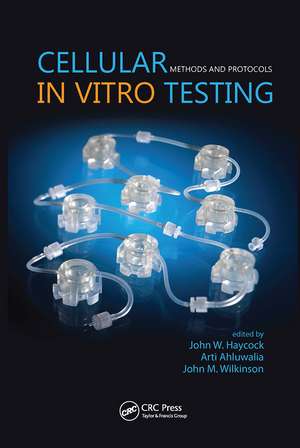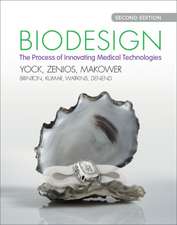Cellular In Vitro Testing: Methods and Protocols
Editat de John Haycock, Arti Ahluwalia, J. Malcolm Wilkinsonen Limba Engleză Hardback – 27 aug 2014
Preț: 559.36 lei
Preț vechi: 749.23 lei
-25% Nou
Puncte Express: 839
Preț estimativ în valută:
107.05€ • 116.24$ • 89.92£
107.05€ • 116.24$ • 89.92£
Carte tipărită la comandă
Livrare economică 22 aprilie-06 mai
Preluare comenzi: 021 569.72.76
Specificații
ISBN-13: 9789814364973
ISBN-10: 9814364975
Pagini: 192
Ilustrații: 41 black & white illustrations, 7 colour illustrations
Dimensiuni: 156 x 234 x 15 mm
Greutate: 0.52 kg
Ediția:1
Editura: Jenny Stanford Publishing
Colecția Jenny Stanford Publishing
ISBN-10: 9814364975
Pagini: 192
Ilustrații: 41 black & white illustrations, 7 colour illustrations
Dimensiuni: 156 x 234 x 15 mm
Greutate: 0.52 kg
Ediția:1
Editura: Jenny Stanford Publishing
Colecția Jenny Stanford Publishing
Public țintă
Academic and PostgraduateNotă biografică
John W. Haycock is director of the Centre for Biomaterials and Tissue Engineering and associate director of the Kroto Research Institute, University of Sheffield, UK. He has a PhD in neuroscience from Newcastle University, UK. His key areas of work include scaffolds for nerve injury repair, 3D nerve models as alternatives for animal testing, and 3D imaging. Prof. Haycock is a member of the EPSRC Peer Review College, UK, and internationally has served on grant-awarding panels and examination bodies in Canada (CFI), Finland, and Sweden.
Arti Ahluwalia is associate professor of bioengineering at the Department of Information Engineering, Faculty of Engineering; vice director of Interdepartmental Research Center "E. Piaggio"; and head of the MCB Group, University of Pisa, Italy. She is currently affiliated with National Council of Research Institute of Clinical Physiology (CNR-IFC), Italy, and is director of its NanoBioScopy Lab. Dr. Ahluwalia has a PhD in bioengineering from the Polytechnic of Milan, Italy. Her research is mainly centered on the interactions between biological systems and man-made materials devices or structures for the creation of organ and system models in vitro, tissue engineering, biosensing, robots for autism, bioreactors, and in vitro models.
John M. Wilkinson is the founder and managing director of Kirkstall Ltd., UK. Prior to founding Kirkstall, he had been managing a high-technology consulting company in Cambridge, UK, following a career in high-technology product development in both large corporations and startups. Dr. Wilkinson earned his PhD from Middlesex University, UK. He is a fellow of the Institute of Nanotechnology, UK, and has been a visiting lecturer for FSRM, Neuchatel, Switzerland, on the subject of micro- and nanotechnology in biomedical engineering for over ten years.
Arti Ahluwalia is associate professor of bioengineering at the Department of Information Engineering, Faculty of Engineering; vice director of Interdepartmental Research Center "E. Piaggio"; and head of the MCB Group, University of Pisa, Italy. She is currently affiliated with National Council of Research Institute of Clinical Physiology (CNR-IFC), Italy, and is director of its NanoBioScopy Lab. Dr. Ahluwalia has a PhD in bioengineering from the Polytechnic of Milan, Italy. Her research is mainly centered on the interactions between biological systems and man-made materials devices or structures for the creation of organ and system models in vitro, tissue engineering, biosensing, robots for autism, bioreactors, and in vitro models.
John M. Wilkinson is the founder and managing director of Kirkstall Ltd., UK. Prior to founding Kirkstall, he had been managing a high-technology consulting company in Cambridge, UK, following a career in high-technology product development in both large corporations and startups. Dr. Wilkinson earned his PhD from Middlesex University, UK. He is a fellow of the Institute of Nanotechnology, UK, and has been a visiting lecturer for FSRM, Neuchatel, Switzerland, on the subject of micro- and nanotechnology in biomedical engineering for over ten years.
Cuprins
Preface, Chapter 1: Methods for Conducting Connected Culture Experiments Using the Quasi-Vivo® Chambers, Chapter 2: The Use of in vitro 3D Cell Models of Human Airway Epithelia (MucilAir™) in Inhalation Toxicity, Chapter 3: Cultivation of Human Hepatocytes in the Quasi-Vivo® System: From Isolation and Seeding to Quantification of Xenobiotic-Metabolizing Enzyme Expression and Activity, Chapter 4: Generation of Patient-Specific Cardiac Patches by Human Cardiac Progenitor Cells and 3D Scaffolds, Chapter 5: In vitro Risk Assessment of Nanoparticles, Chapter 6: Utilizing Nanosensor-Incorporated Scaffolds in the Development of a 3D Lung Model, Chapter 7: Development of a Paracrine-Signaling Model for Detecting Irritancy Using Human Keratinocytes and Fibroblasts, Chapter 8: Advanced in vitro Models of the Intestinal Mucosa for Drug Delivery Studies, Chapter 9: An in vitro NHBE Model of the Human Bronchial Epithelium, Chapter 10: Method for Simple and Routine Three-Dimensional Cell Culture
Descriere
Growing cells in 2D under static conditions has long been the gold standard of cell culture, despite this method not being representative of the complex in vivo environment. The use of animal models also has clear ethical and scientific limitations, and increasingly the 3Rs (replacement, refinement, reduction) in relation to animal models are being integrated into the modern-day scientific practice.
Focusing on new 3D in vitro methods now available to researchers, this book brings together examples of leading-edge work being conducted internationally for improving in vitro cell culture methods, in particular the use of systems for enabling cell culture under laminar flow and the use of 3D scaffolds for providing cells with a structure which replicates the function of the extracellular matrix and encouraging interactions more akin to an in vivo environment.
Focusing on new 3D in vitro methods now available to researchers, this book brings together examples of leading-edge work being conducted internationally for improving in vitro cell culture methods, in particular the use of systems for enabling cell culture under laminar flow and the use of 3D scaffolds for providing cells with a structure which replicates the function of the extracellular matrix and encouraging interactions more akin to an in vivo environment.















